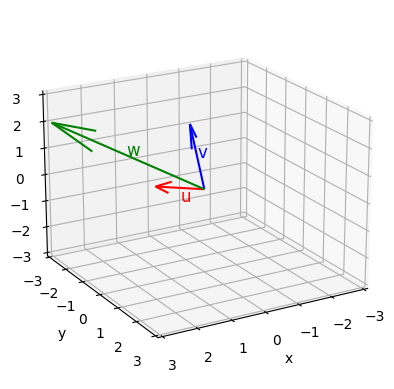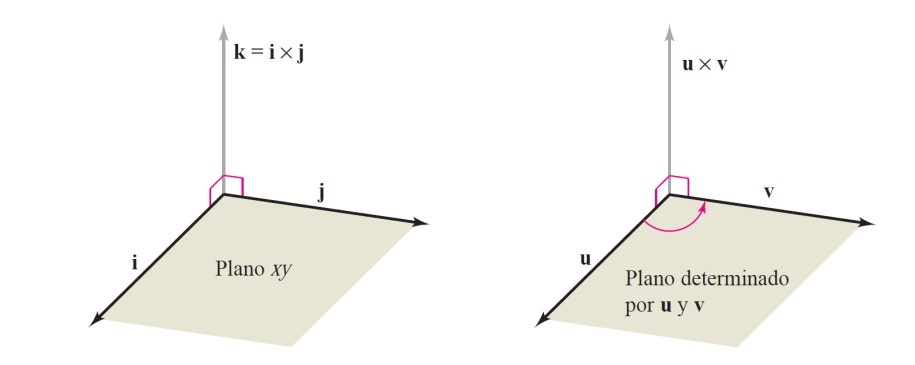1.4. El producto vectorial#
En esta sección vamos a aprender a manejar el producto vectorial, una aplicación que, dados dos vectores no nulos en \(\mathbb{R}^3\), nos permite calcular un tercer vector ortogonal a los dos dados.
1.4.1. Producto vectorial. Definición y propiedades#
Definition (Producto vectorial)
Sean \(\mathbf{u}=\left( u_{1}, u_{2}, u_{3} \right) = u_{1}\mathbf{i} + u_{2}\mathbf{j} + u_{3}\mathbf{k}\) y \(\mathbf{v}=\left( v_{1}, v_{2}, v_{3} \right) = v_{1}\mathbf{i} + v_{2}\mathbf{j} + v_{3}\mathbf{k}\) dos vectores no nulos. Definimos su producto vectorial como el vector
Suele representarse, aprovechando la notación de determinantes, y desarrollando por los menores de la primera fila,
Veamos un ejemplo, aprovechando la función np.cross de Numpy, que calcula directamente el producto vectorial:
import numpy as np
import matplotlib as mp
import matplotlib.pyplot as plt
# Definimos los vectores u y v
u = np.array([2, 1, 1])
v = np.array([1, 1, 3])
# Calculamos su producto vectorial con la función, de Numpy, np.cross
w = np.cross(u,v)
display(w)
# Inicialización de la representación 3D
fig = plt.figure()
ax = fig.add_subplot(111, projection='3d')
# Representación de los vectores
ax.quiver([0], [0], [0], np.array([u[0], v[0], w[0]]), np.array([u[1], v[1], w[1]]),
np.array([u[2], v[2], w[2]]), color=['r','b','g','r','r','b','b','g','g'])
# Añadimos etiquetas a los vectores
ax.text(u[0]/2, u[1]/2, u[2]/2-0.5, 'u', fontsize=12, color='r')
ax.text(v[0]/2, v[1]/2, v[2]/2, 'v', fontsize=12, color='b')
ax.text(w[0]/2, w[1]/2, w[2]/2, 'w', fontsize=12, color='g')
# Ajuste de los límites de los ejes
ax.set_xlim([-3,3])
ax.set_ylim([-3,3])
ax.set_zlim([-3,3])
# Etiquetas de los ejes
ax.set_xlabel('x')
ax.set_ylabel('y')
ax.set_zlabel('z')
# Orientamos los ejes
ax.azim = 60
ax.elev = 20
plt.show()
array([ 2, -5, 1])

Veamos a continuación algunas propiedades del producto vectorial:
Property (Propiedades algebraicas del producto vectorial)
Sean \(\mathbf{u}\), \(\mathbf{v}\) y \(\mathbf{w} \in\mathbb{R}^{3}\) y sea \(c\in\mathbb{R}\). Se cumple
\(\mathbf{u}\times\mathbf{v} = -\left( \mathbf{v}\times\mathbf{u} \right)\) (anticonmutativa).
\(\mathbf{u}\times\left( \mathbf{v} + \mathbf{w} \right) = \left(\mathbf{u}\times\mathbf{v}\right) + \left(\mathbf{u}\times\mathbf{w}\right)\) (distributiva respecto a la suma).
\(c \left( \mathbf{u} \times \mathbf{v} \right) = \left(c \mathbf{u}\right) \times \mathbf{v} = \mathbf{u} \times \left(c \mathbf{v}\right)\).
\(\mathbf{u} \times \mathbf{0} = \mathbf{0} \times \mathbf{u} = \mathbf{0}\).
\(\mathbf{u} \times \mathbf{u} = \mathbf{0}\).
\(\mathbf{u}\cdot\left( \mathbf{v} \times \mathbf{w} \right) = \left( \mathbf{u} \times \mathbf{v} \right) \cdot \mathbf{w}\).
Property (Propiedades geométricas del producto vectorial)
Sean \(\mathbf{u}\), \(\mathbf{v} \in\mathbb{R}^{3}\) vectores distintos de \(\mathbf{0}\) y sea \(\theta\) el ángulo entre ellos. Se cumple
\(\mathbf{u}\times\mathbf{v}\) es ortogonal tanto a \(\mathbf{u}\) como a \(\mathbf{v}\).
\(\| \mathbf{u}\times\mathbf{v} \| = \| \mathbf{u} \| \| \mathbf{v} \| \sin\theta\).
\( \mathbf{u}\times\mathbf{v} = \mathbf{0}\) si y sólo si \(\mathbf{u}\) y \(\mathbf{v}\) son paralelos (es decir, si \(\exists c\in\mathbb{R}\) tal que \(\mathbf{v} = c \mathbf{u}\)).
\(\| \mathbf{u}\times\mathbf{v} \|\) es igual al área del paralelogramo que tiene a \(\mathbf{u}\) y a \(\mathbf{v}\) como lados adyacentes.
Para ver la orientación de \(\mathbf{u}\times\mathbf{v}\) se puede utilizar la regla del sacacorchos entre \(\mathbf{u}\) y \(\mathbf{v}\), como se muestra en la siguiente figura:


